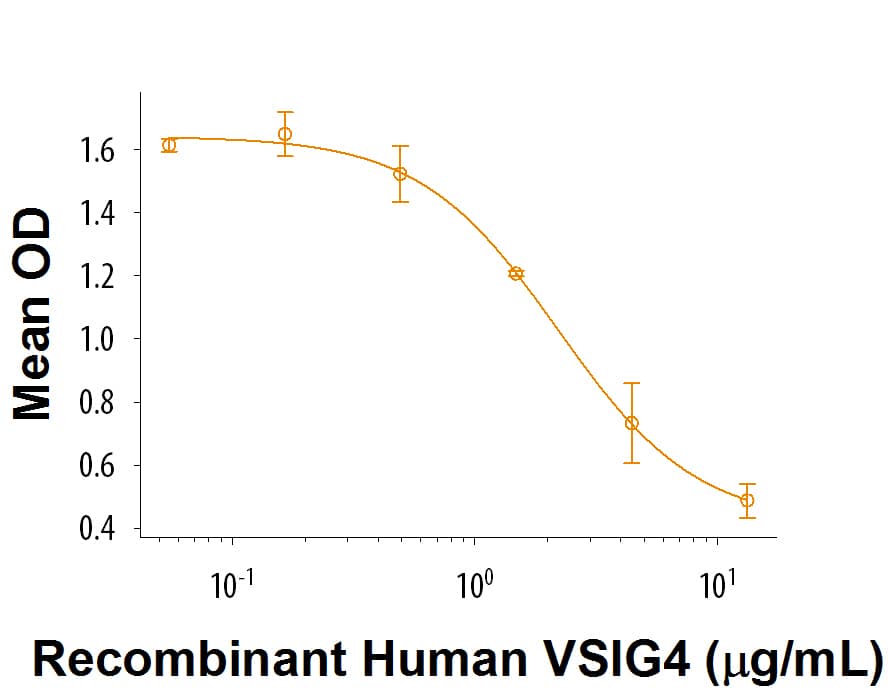Recombinant Human VSIG4 Short Isoform Fc Chimera Protein, CF
R&D Systems, part of Bio-Techne | Catalog # 9817-VS

Key Product Details
Source
CHO
Accession #
Structure / Form
Disulfide-linked homodimer
Conjugate
Unconjugated
Applications
Bioactivity
Product Specifications
Source
Chinese Hamster Ovary cell line, CHO-derived human VSIG4 protein
| Human VSIG4 (Arg20-Pro189) Accession # Q9Y279-3 |
IEGRMD | Human IgG1 (Pro100-Lys330) |
| N-terminus | C-terminus |
Purity
>95%, by SDS-PAGE visualized with Silver Staining and quantitative densitometry by Coomassie® Blue Staining.
Endotoxin Level
<0.10 EU per 1 μg of the protein by the LAL method.
N-terminal Sequence Analysis
Arg20
Predicted Molecular Mass
46 kDa
SDS-PAGE
55-65 kDa, reducing conditions
Activity
Measured by its ability to inhibit anti-CD3 antibody induced IFN-gamma secretion by human peripheral blood mononuclear cells (PBMC).
The ED50 for this effect is 1-5 μg/mL.
The ED50 for this effect is 1-5 μg/mL.
Scientific Data Images for Recombinant Human VSIG4 Short Isoform Fc Chimera Protein, CF
Recombinant Human VSIG4 Short Isoform Fc Chimera Protein Bioactivity
Recombinant Human VSIG4 Fc Chimera (Catalog # 9817-VS) inhibits IFN-gamma secretion by human peripheral blood mononuclear cells in the presence of anti-CD3 antibody. The ED50 for this effect is 1-5 μg/mL.Formulation, Preparation and Storage
9817-VS
| Formulation | Lyophilized from a 0.2 μm filtered solution in PBS. |
| Reconstitution |
Reconstitute at 200 μg/mL in PBS.
|
| Shipping | The product is shipped at ambient temperature. Upon receipt, store it immediately at the temperature recommended below. |
| Stability & Storage | Use a manual defrost freezer and avoid repeated freeze-thaw cycles.
|
Background: VSIG4
References
- He, J.Q. et al. (2008) Mol. Immunol. 4041.
- Vogt, L. et al. (2006) J. Clin. Invest. 116:2817.
- Langnaese, K. et al. (2000) Biochim. Biophys. Acta 1492:522.
- Helmy, K. et al. (2006) Cell 124:915.
- Small, A.G. et al. (2016) Swiss Med. Wkly. 146:w14301.
- Tanaka, M. et al. (2008) Clin. Exp. Immunol. 154:38.
- Lee, M-Y. et al. (2006) J. Leukoc. Biol. 80:922.
- Gorgani, N.N. et al. (2008) J. Immunol. 181:7902.
- Walker, M.G. (2002) Biochim. Biophys. Acta 1574:387.
- Wiesmann, C. et al. (2006) Nature 444:217.
- Katschke, K.J. et al. (2007) J. Exp. Med. 204:1319.
- Li, J. et al. (2017) Nat Commun. 8:1322.
- Byun, JM. et al. (2017) Int J Gynecol Cancer. 27:872.
- Roh, J. et al. (2017) Oncotarget. 8:58122.
Long Name
V-Set and Immunoglobulin Domain Containing 4
Alternate Names
Z39IG
Gene Symbol
VSIG4
UniProt
Additional VSIG4 Products
Product Documents for Recombinant Human VSIG4 Short Isoform Fc Chimera Protein, CF
Product Specific Notices for Recombinant Human VSIG4 Short Isoform Fc Chimera Protein, CF
For research use only
